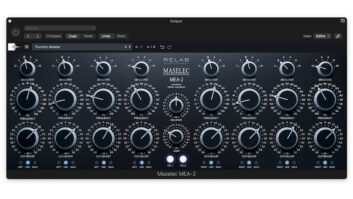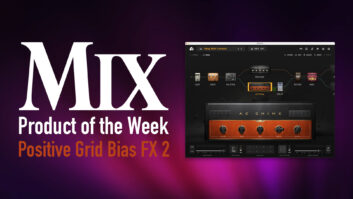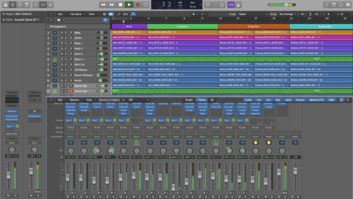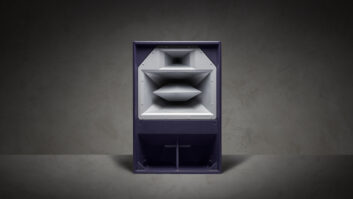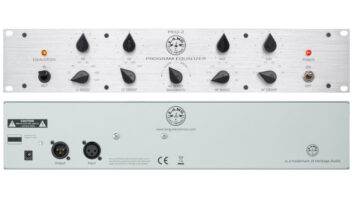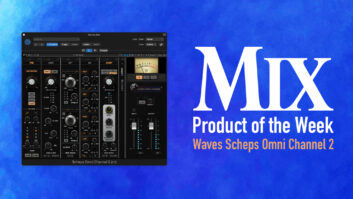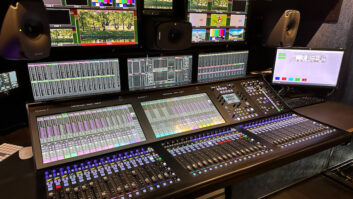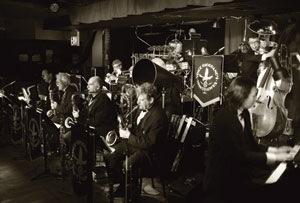
Vince Giordano & the Nighthawks
Photo: Paul Goldfinger
In HBO’s stellar series Boardwalk Empire, music may enhance, or undercut, a scene of joyous debauchery, violence or sorrow. But whatever the mood, the songs are always meticulously matched to the 1920s era of the show.
“It’s such a period piece, and the filmmakers—Martin Scorsese and Terence Winter—are period-specific,” says engineer/producer Stewart Lerman, who worked on the songs for Boardwalk Empire Volume 2 with co-producer Randall Poster. “When we’re recording something from 1924, it has to be right for 1924, whether that’s the instrumentation or the style of the song.”
This latest soundtrack includes performances by a varied group of singers—Rufus Wainwright, St. Vincent, Elvis Costello, Patti Smith and Liza Minnelli, to name a few—all backed by ’20s-style big band Vince Giordano & the Nighthawks.

Randall Poster (L) with Stewart Lerman
Photo: Charlie Gross
“This music is pre-acoustic bass,” Lerman points out. “The main bottom instrument was the tuba, and after that the bass saxophone. [In Season 4], we’re introducing the bass saxophone, and that’s right for the years we’re working on, 1924 and ‘25. Also, no guitars—it’s banjo.
“We’re very specific about the drums, too,” he continues. “They’re animal-skinned, old drums. They used to paint the head of the bass drum that you would see from the audience—it would have a palm tree or something—and then put a light in it to bring it up to a temperature where the skin would have the right resonance. It would also look really cool! And then there’s wood blocks and a lot of coconut shell-type sounds. Our bandleader, Vince, is a collector of these instruments.”
Lerman and Poster record in New York facilities with large, well-tuned studios of similar size to the speakeasy featured on Boardwalk Empire: Avatar Studios, Brooklyn Recording, Electric Lady, Sear Sound. The room tones reinforce the sense of being in Babette’s or the Onyx Club.

Lerman with David Johansen, a contributor to Boardwalk Empire Volume 2.
“What really gives this a certain patina is the musical arrangements and the players,” says Lerman, who also engineered and co-produced the Grammy-winning Volume 1 soundtrack. “You can take an old carbon microphone and record a musician who’s playing in a modern style, and it’s not going to sound old. Conversely, you get these guys who are experts, right down to their vibrato, and that allows me to capture vintage in a modern way. I’m recording digitally [to Pro Tools], but at the front end of everything I’m using as many ribbon and valve [tube] microphones as I can. The studios we work in have great mic collections.”
Lerman has been tracking period music in these studios for nearly a decade, and he says that, thanks to their stellar assistant engineers’ familiarity with his work, equipment is all set up before he arrives for a session, including various room mics—typically RCA 77s or Coles 4038s—and close mics on every band instrument. “Close miking allows me to make adjustments if I need to in mixing,” he says. “But also if I have the saxophone player on one side of the room and the trumpet player on the other side, those mics can act as room mics for each other. Every mic is potentially a room mic.”
At the start of a session, the band runs through the song a couple times before tracking live with the singer. “After we get the take, we’ll have the vocalist try a couple more times, take a 15-minute break, come back, and then sing to the track. Then I can comp if I need to later,” Lerman says.
While at Sear Sound, Lerman captured the mournful blues song “Nobody Knows You When You’re Down And Out,” sung by Neko Case. “At Sear they have one of the sweetest [Neumann] M 49s I’ve ever heard, so I’ll always start with that,” he says. “I had that set up, but she said, ‘Can we just hear what the [Shure] 57 sounds like?’ I put a 57 up next to the M 49, and she just was more comfortable on the 57, so that’s what we used.”

Lerman was also impressed with vocalist/actress Margot Bingham, who recently joined the Boardwalk cast and sings “I’m Going South.” “She’s unbelievable,” he says. “We recorded her at Brooklyn with a U 48; she has a deep voice, but it’s very bright. It’s a great combination of richness with a really clear top end, and that mic worked really sweet on her. She’s probably the only vocalist who’s going to be new to the public.”
Definitely not new-to-the-public is Liza Minnelli, who sang into a U 47, via an LA-2A and the Neve 8068 board in Avatar Studio A. “She sang with the Rat Pack—Sinatra and Sammy Davis! I was freaking out,” Lerman says, “but she put us so at ease. Immediately, she walked in and said, ‘Let me just go out and sit with the band.’ We gave her headphones, and she just sat in the corner and listened to them run the tune. Then she just tore it up. And she was so easy; she would say, ‘Want me to sing some more? Whatever you want. I take direction very well. My father was a director, you know!’”
Lerman mixed the album in the personal studio he shares with musician/producer Tony Shanahan, Hobo Sound, where he works on a vintage Electrodyne console. “I mainly use what’s on the console, but I’ll often touch it up with a stereo limiter on the bus, maybe a [ADR] Compex or an SSL stereo limiter,” Lerman says. “One of the things we’ve considered carefully about old records that we love from the ‘20s is that they’re sonically compromised. We’re not trying to actually do this the way they did, because that was not optimal; oftentimes on those recordings, you can’t hear half the instruments. Instead, we’re trying to maintain the art form as close as possible but update it in some slight but special way.”
Mastering the ’20s at Sterling Sound
The vintage musical creations for Boardwalk Empire Volume 2 were mastered by Greg Calbi at Sterling Sound. “Greg has mastered so many records for me. It’s really good to know that when I’m done being as artistic as I want to be, he’s got my back,” Lerman says.
The appreciation is apparently mutual: “Stewart’s projects are mixed so beautifully,” Calbi says. “This was very easy and quick. The main thing on a project like this is just to try to keep the natural sound. Because of the nature of these early 20th-century instruments and arrangements, you don’t want to introduce any sonic artificiality. I experimented with different interconnects from my D-to-A converter to my console, because just the transfer into the console or the A-to-D on the way out gives a certain color.”
Calbi felt Wireworld Gold Cable and Ayre Acoustics QA-9 ADC converters formed the most neutral path into his custom Muth mastering console. He monitors on the same Proac Response 4 speakers he’s used since 1992. “But with a project like this that was mixed so well, where the vocals are always intact and clear, there’s not a lot of EQ that needs to be done,” he says. “Going song-by-song through my notes, I can see there were a lot of them where I didn’t do any augmentation to the midrange at all.
“The technique I use when I’m mastering an album is to constantly compare to the tracks I’ve already mastered, and keep a consistent presence,” Calbi continues. “It’s not necessarily to get a consistent level of the bass or of the vocal, but to make sure that nothing comes in where it doesn’t have the right kind of impact or feel.”

